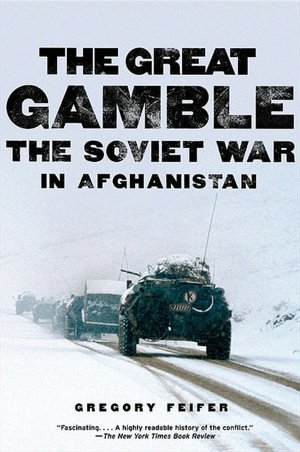My book club met this evening to discuss The Great Gamble: The Soviet War in Afghanistan by Gregory Feifer. The book focuses only on the role of the Soviet Union during its military adventure in Afghanistan. I came out of the meeting with the feeling that there were some similarities and some differences between the U.S. role in Afghanistan now and that of the Soviets from 1979 to 1989.
Similarities
Decision making in the Kremlin and decision making in the White House were probably done by people who failed to mine the knowledge in their countries on Afghanistan and as a result who sent troops on missions which would prove far more difficult than originally imagined.
War in Afghanistan was not in the critical national interest of either the Soviet Union nor the United States.
In both cases the world power came to support a client government, with the intent of modernizing Afghan society (schools, women's rights, roads, etc.), assuming that the Afghan people would easily accept the ideology of the world power (Communism for the Soviets, Democracy for the Americans), and in both cases the reforming Afghan government had less support than supposed.
In both cases, the world power underestimated the willingness of other (typically bordering) nations to support insurgents. Since the most important ethnic groups (Turkmen, Uzbeks, Tajiks, Pashtuns, Baluchis, Hazara) all have links crossing borders with related ethnic groups, this failure of imagination seems strange.
And of course, in both cases the world power found itself pulling out of military involvement in Afghanistan after a decade, in part due to its own domestic economic problems.
Differences
The Soviet Union included Turkmen, Uzbeks and Tajiks, and troops from those republics were initially sent to Afghanistan under the (apparently misguided) assumption that they would be more acceptable to the Afghans.
The military forces were quite different. The Soviet military was based on conscription while the American army was all volunteer; thus the American soldier is often older than his Soviet counterpart was, and often more extensively trained. American soldiers often had multiple tours in war zones, especially in the later years, while the Soviet conscripts typically had only a single tour. The Soviet military was very poorly supplied while the the American military was lavishly supplied. The American military has a strong cadre of non-commissioned officers which the Soviet military lacked.
Bottom Line
While some of the club members disliked the book before the meeting, the discussion seemed to change their minds and to result in a rather positive judgement on the book's merit.
The mission assigned to the U.S. military changed over time from overthrowing the Taliban government and destroying the threat posed to the United State by Al Qaeda to supporting the institutionalization of the Karzai government so that it could sustain power. The club members wished that the Bush White House decision makers had read this book before making that mission change.
It probably would have been easier to reduce the threat posed to Americans by Al Qaeda to acceptable levels by directly attacking Al Qaeda than by installing a sustainable government in Afghanistan that would not tolerate Al Qaeda presence on its soil.
Other
I am not sure that we fully explored the reasons that Pakistan and Iran have for their policies toward Afghanistan. For example, Pakistan's water resources come largely from Afghanistan so it is important to Pakistan to have a government in Afghanistan with which it can work on water resource management.
We probably should have given more thought to the misery of the Soviet soldiers assigned to Afghanistan, and the even greater, longer lasting misery of the Afghan people beset by seemingly endless war.
The Pakistan Army, which is very influential in Pakistani policy, has large numbers of Pashtuns, Punjabi Pathans, and Baluchis.

No comments:
Post a Comment